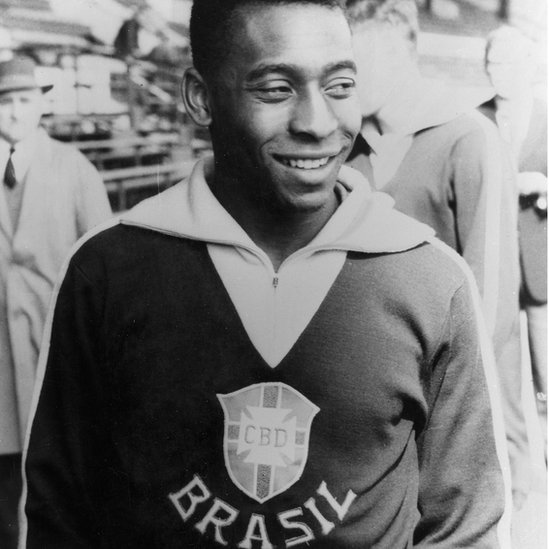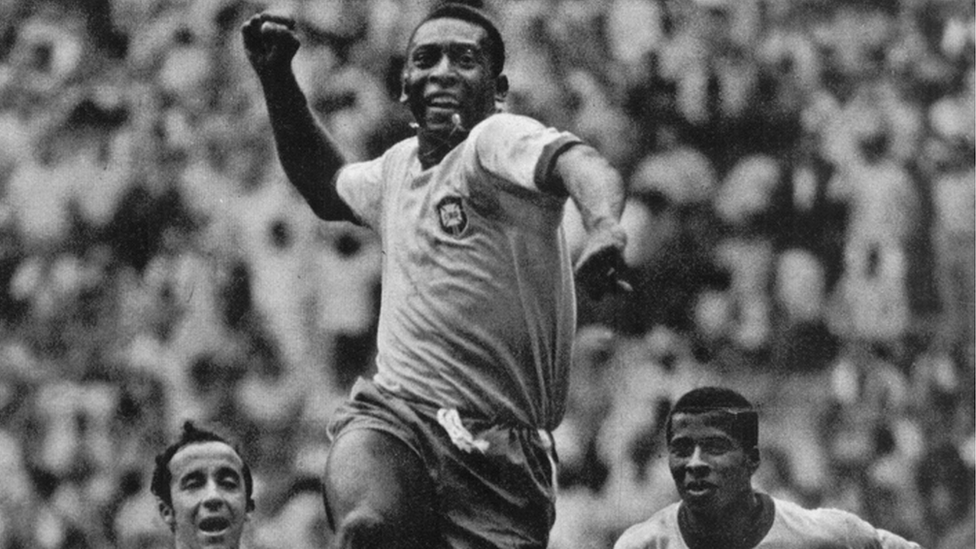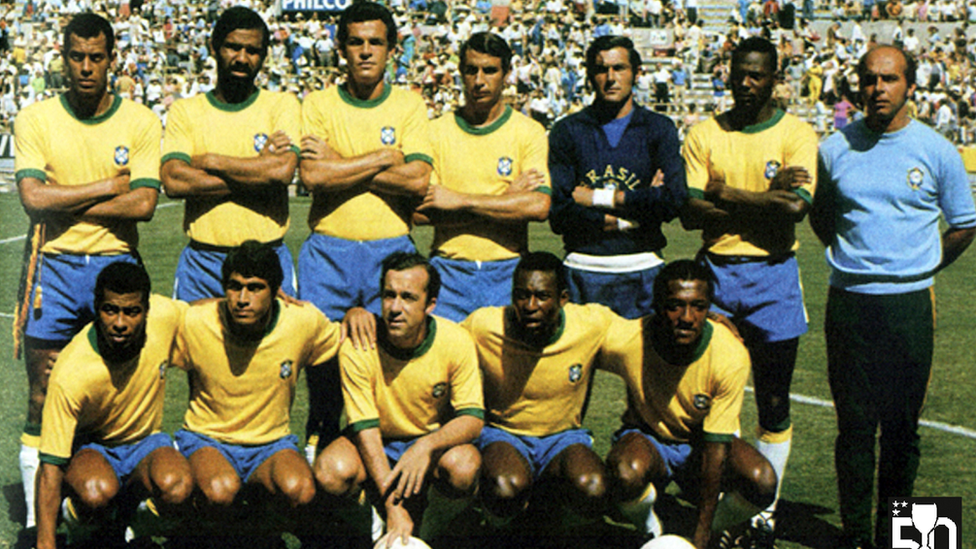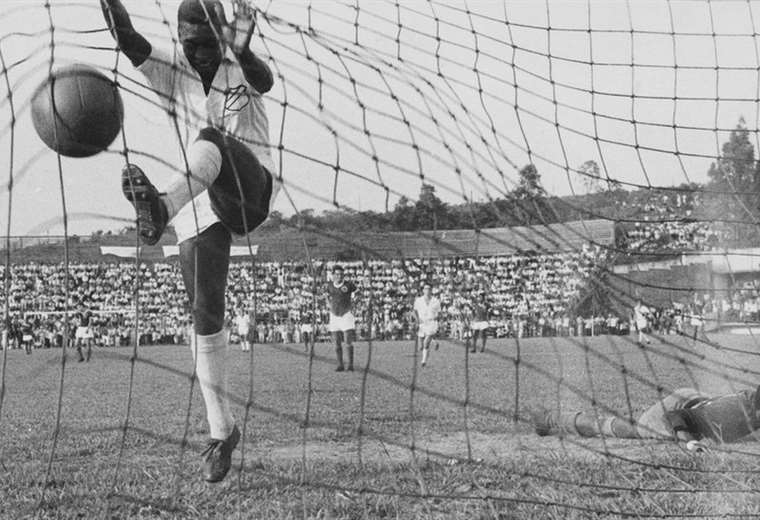December 30, 2022, 7:18 AM
December 30, 2022, 7:18 AM
On February 26, 1958, the Santos and América-RJ teams met for the first round of the Rio-Sao Paulo Tournament. The Santos club beat the Rio team 5-3. Of the five Santos goals, four were from Pele.
“On his own, he finished the game, he monopolized the score,” declared journalist Nelson Rodrigues (1912-1980).
Present at the Maracana, the author of À Sombra das Chuteiras Immortais (“In the shadow of the immortal boots”, 1998) he liked the performance of the boy, then 17 years old, so much that he dedicated an entire chronicle to him: “Pelé’s royalty”.
It was the first time, says the journalist Ruy Castro in his biography O Pornographic Craving (“Pornographic Angel”, 1992), that Edson Arantes do Nascimento, Pelé, who died this Thursday, December 29 at the age of 82, was called the “king of soccer”.
“Pelé has a considerable advantage over the other playersto feel like a king, from head to toe”, wrote Rodrigues in the chronicle published in the magazine sportive mancheteon March 8, 1958.
“When you catch the ball and dribble an opponent it’s like shooing away a lousy, ignorant commoner.”
Of the four goals that Pelé scored against goalkeeper Pompeii, one of them caught the attention of the chronicler.
The one in which before putting the ball in, the ace dribbles the first, doubles the second and cuts the third defender. “Until there came a time when there was no one left to dribble. There was no defense. Or in another way: the defense was defenseless“, joked the journalist.
In the chronicle, Rodrigues confesses that he was scared when he found out how old Pelé was: 17 years old!
“He’s a boy, a boy. If he wanted to be in a Brigitte Bardot movie, they’d ban him,” he wrote in the “My Character of the Year” column in January 1959.
“But look: he is an unquestionable genius! Whether it is Michelangelo, Homer or Dante, he greets them with intimate effusiveness: ‘How are you, colleague?'”.

To describe what he saw that Wednesday night, Rodrigues abused adjectives: “great”, “perfect”, “fabulous”, “unbeatable”, “incomparable”. “Go play well like this, may the devil take him.”
Three months after the publication of the prophetic chronicle, the first to call Pelé king, the star and the Brazilian soccer team were crowned champions in the World Cup in Sweden.
In 1975, when the star was already wearing the Cosmos jersey, Rodrigues declared: “Ask any zebra in the zoo: ‘Who is the best player in the world?’ All the zebras will say, with warm unanimity: ‘Pele’.” .
And he concluded: “From the Eskimo to the Chinese, from the Russian to the German, from the Patagonian to the Egyptian, everyone thinks that Pelé is truly the great player of the present, past and future.”
literary themes
Nelson Rodrigues was not the only one to praise Pelé’s talent.
Throughout the decades, other authors, from different styles and generations, wrote stories, poems and even novels, paying homage to the “most complete player that ever lived”, as Ruy Castro would say.
The Minas Gerais poet Carlos Drummond de Andrade (1902-1987), author of When is Football Day (“When it’s football day”), he wrote: “The difficult thing, the extraordinary thing, is not scoring a thousand goals, like Pelé. It is to score a goal like Pele“.
For his part, the gaucho columnist Luís Fernando Veríssimo wrote in his work “Dream Team. Passion, poetry and football” (2010): “Pelé was good even tying his boots.”
Everyone has their favorite moment. That of the writer from Minas Gerais Mário Prata, author of Paris, 98! (2005), about the World Cup in France, is “totally unknown”.
Pelé must have been 12 years old and played for Baquinho, the Bauru children’s team, a club in the interior of São Paulo where the boy gave his first dribbles.
In a match, Prata recounts, Pelé received the ball with his back to the opponent’s goal and, without looking back, hit it with his heel. Conclution? The ball went into the angle.
At the break, the coach scolded the boy like this: “Oh man, you didn’t have to do that. The possibility of making a mistake was great. There was room to turn around and shoot from the front.”
Pele replied: “He’s right. I wasn’t looking at your goal, was watching the oura“, reproduces Prata.
The favorite move of the São Paulo writer Ignácio de Loyola Brandão, author of “El gol”, included in the anthology 22 Contistas in the Field (“22 counters on the field”, 2006), was the goal that Pelé scored at Juventus Stadium, in Sao Paulo, on August 2, 1959.
The match ended in a win: 4-0 for Santos.
“I had never seen a goal so narrated, described, commented on, discussed, applauded, idolized, mythologized. I did not see that goal. But they all saw it. The stadium seats 4,000 fans in 1950,” she says wryly.


The Brazilian writer Milton Hatoum also cites a goal as the king of soccer’s masterful play.
“Pelé scored dozens of incredible goals. One of the most beautiful was the one he scored against Sweden“, he chooses, going back to the 1958 World Cup.
He himself narrates the maneuver: a player makes a long cross into the area. Pelé controls the ball, takes a hat off a defender and, without letting the ball touch the grass, kicks it into the goalkeeper’s right corner.
“A historic goal,” defines. “Unfortunately, Brazil does not celebrate its true myths and heroes.”
São Paulo journalist Juca Kfouri, author of several books on soccer, such as Meninos Eu Vi (“Chicos que vi”, 2003), among others, choose not a goal, like Prata, Loyola or Hatoum, but a goal attempt.
The midfield shot against Czechoslovakia, in the 1970 World Cup. “After being the goal that Pelé did not score for years, the truth is that nobody had tried it before,” he explains.
The Minas Gerais writer Luiz Ruffato, who edited Enter as Four Lines (“Between four lines”, 2013), an anthology of short stories about soccer, also points out what he likes most about the athlete of the century.
“It may be a bit obvious, but the most beautiful shot was the first goal in the 1970 World Cup final against Italy“.
Tostão shoots down the flank for Rivelino who, in a single touch, puts the ball on Pelé’s head. Goal!
“I remember the cries of joy from the people in my neighborhood, poor people who worked in cloth factories, and who at that moment felt like kings like Pelé. I was a child, I was 9 years old, but even today, I get emotional when I remember that match…”, he confesses.
From artist to creator

For four writers, the most beautiful shot of all time by the best soccer player in history was not a goal, but a dribble.
The classic dribble from the body of the Uruguayan goalkeeper Ladislao Mazurkiewicz (1945-2013) in the semifinal of the 1970 World Cup in Mexico.
“A seldom seen dribble”, points out the Rio de Janeiro writer Carlos Eduardo Novaes, author of the chronicle “The King of Superstition”, from the anthology Once in the Field and a Bank of Primeira (“Eleven in the field and a first-class bench”, 1998). “Vision of the game and quick thinking of someone who knows what to do on the pitcheither”.
Before choosing his favorite move, Brazilian writer Cristovão Tezza makes sure to review it “for the thousandth time.”
“It’s a ‘conceptual’ thing,” he says. “So beautiful that the absence of a goal became irrelevant”, says the author of “A moral question”, a story included in the collection Between the Four Lines (“Between the four lines”), by Luiz Ruffato.
author of Os Cabeças de Catfish Also Deserve Paradise (“The catfish heads also deserve paradise”, 2001), among other books on football, the writer and screenwriter for Santos José Roberto Torero also votes for Pelé’s dribbling without the ball in Mazurkiewicz.
“It was a completely new dribble, which had never been seen before. At that moment, Pelé stopped being an artist to become a creator. He made a masterpiece, but a true masterpiece, something he had never done before”, he justifies.
The writer and journalist from Minas Gerais, Sérgio Rodrigues, liked the idea so much that he did not dedicate a chronicle or a short story to it, but rather a novel, Or Dribble (“The dribble”, 2013). In the book, the nine seconds of play are described on six pages.
“In addition to the amazing capacity for football fantasy, the instantaneous creation of an unprecedented event that alters the same temporal and spatial coordinates of the game, what I see in this play is a guarantee of permanence precisely because of its inconsistency. If it had resulted in a goal, It would have been nice, but reassuring. Since the ball did not go in, it will burn our eyes forever“.
Now you can receive notifications from BBC Mundo. Download the new version of our app and activate them so you don’t miss out on our best content.


















